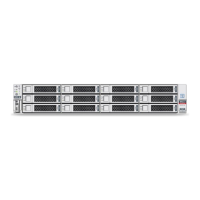Servicing the DIMMs (CRU)
92 Oracle Server X6-2 Service Manual • June 2016
Population Order DIMM Sockets for Processor
0 (P0)
DIMM Sockets for Processor 1
(P1)
Memory Channels
Twelfth Fill D6 first Then fill D6 Ch B
DIMM Operating Speeds
The maximum supported memory speed is 2400 MT/s. However, not all system configurations
will support operation at this speed. The maximum attainable memory speed will be limited
by the maximum speed supported by the specific type of processor and the specific memory
population. All memory installed in the system will operate at the same speed, or frequency.
DIMM Rank Classification Labels
DIMMs come in a variety of ranks: dual or quad. Each DIMM is shipped with a label
identifying its rank classification. The following table identifies the label corresponding to each
DIMM rank classification.
TABLE 14
DIMM Rank Classifications Labels
Rank Classification Label
Quad-rank LRDIMM 4Rx4
Dual-rank RDIMM 2Rx4
Inconsistencies Between DIMM Fault Indicators
and the BIOS Isolation of Failed DIMMs
When a single DIMM is marked as failed by Oracle ILOM (for example, fault.memory.
intel.dimm.training-failed is listed in the service processor Event Log), BIOS might
disable the entire memory channel that contains the failed DIMM, up to three DIMMs. As a
result, none of the memory installed in the disabled channel will be available to the operating
system. However, when the Fault Remind button is pressed, only the fault status indicator
(LED) associated with the failed DIMM lights. The fault LEDs for the other DIMMs in the
memory channel remain off. Therefore, you can correctly identify the failed DIMM using the lit
LED.
Using the Server Fault Remind Button
When the Fault Remind button is pressed, an LED located next to the Fault Remind button
lights green to indicate that there is sufficient voltage present in the fault remind circuit to light

